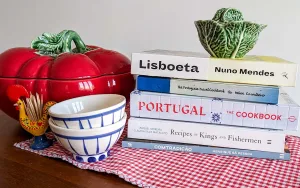Fresh seafood, hearty stews and heavenly pastries await in the Azores islands. Lost in the middle of the Atlantic Ocean, the volcanic archipelago of nine islands offers up many unique dishes and unusual ingredients, partly thanks to its climate and remote location.
Taste the thermal-cooked Cozido das Furnas, visit an island best known for its cheese, and eat weird barnacles. From the soul-warming to the bizarre, here are all the dishes, ingredients, desserts and drinks to eat and experience while visiting the Azores.
Contents
ToggleDishes and regional specialties to seek out in the Azores
Limpets – Lapas
If you enjoy eating clams or mussels then you absolutely must try limpets. On the Azores islands you’ll frequently find these conical shellfish grilled (lapas grelhadas) on the menu. The lapas are usually served sizzling in the pan they were cooked in, flavoured with butter, garlic and lemon. The texture is chewier than clams or mussels, but they are fantastic and a must try.



On our first day on São Miguel we stopped at a small town and went to a local restaurant with a cheap lunch buffet. As the only non-locals there, the owner brought over a plate of off-menu lapas for us. Only they weren’t grilled – they were alive! We stared at them for a while, wriggling on the plate, until one of the owner’s friends came over and showed us how to manage them. I’ve honestly never seen them eaten this way since, so don’t panic.
Barnacles – cracas
Another unusual seafood you might spot in the Azores is cracas. These look like moss-covered chunks of rock but are actually another type of sea barnacle. Cracas are boiled in seawater and served chilled.
Read next: What to eat and drink in Madeira: the best local dishes to try
Tuna – atum
A fresh tuna steak between bread is one of my favourite snacks or quick lunches. The Azores, nine islands in the middle of the Atlantic Ocean, are surrounded by prime tuna territory. Enjoy eating fresh tuna steaks wedged in a sandwich, or grilled and served with local yams at restaurants. The perfect souvenir? A tin or two of local tuna conserves.


Octopus stew – Polvo guisado
It’s unlikely that you’ve ever eaten octopus quite like this rich, hearty stew. With garlic, pepper paste, tomato paste, chili, paprika and herbs, there are a lot of strong flavours that the octopus manages to stand up to. Usually it is served over rice, potatoes or a slice of bread – with extra to mop up the delicious sauce.


Bolo lêvedo
Bolo lêvedo is like a flat, English muffin-like bread that is slightly sweet. The breads originally come from the town of Furnas on São Miguel Island and are perfect to eat with sweet or savoury foods. If you’re in the Azores you almost can’t avoid them. Try bolo lêvedo for breakfast with butter and jam, or as a burger with a local tuna steak. Chances are it will arrive in the bread basket at every restaurant.
Read next: 25 traditional dishes to order in Portugal
São Jorge cheese – Queijo São Jorge
Strong, bitey and hard, São Jorge is sometimes referred to as Portugal’s parmesan – but I find it much stronger. Queijo São Jorge is made exclusively with raw dairy milk, produced on the island of the same name, and made the in same way for hundreds of years. The large wheels of cow’s cheese, weighing between eight to 12 kilogram, are usually aged for four to 36 months, resulting in a hard or semi-hard cheese.
Cozido das Furnas
Cozido à Portuguesa is a classic Portuguese dish loved by locals. The dish is essentially a boiled stew with a variety of meats, smoked sausages, potato and cabbage. In the Azores, the Cozido das Furnas (Furnas-style Cozido) is cooked using the hot volcanic earth near the town of Furnas. A big pot filled with cozido ingredients is submerged into the ground, covered over with dirt and left for half a day or more.


Steak – Bife á Regional
As you crisscross the island of São Miguel you’ll see plenty of happy black-and-white cows roaming the vibrant green pastures. While great cheese, milk and butter comes from the Azores, so too does a good slab of quality grass-fed beef. On São Miguel the best place to eat excellent steak is the Restaurante da Associação Agricola de São Miguel, a restaurant attached to the agriculture association. Try the Bife á Regional, served with garlic cloves, red peppers and fries.

Blood sausage – morcela
If you’re a fan of blood sausage, you have to try the Azorean morcela. In restaurants it will often be served up with pineapple – the perfect rich-sweet combo. Give it a try!

Beef stew – Alcatra
This slow-cooked beef stew is Terceira Island’s most famous. Rich and soul-warming, Alcatra is a dish of beef rump slow-cooked with red wine, onions, garlic, allspice and black peppercorns. Usually served with sweet, brioche-like bread called massa sovada.

Azorean sweets and desserts
Pineapple – Ananas
São Miguel has a small pineapple plantation that you can visit to see how this microclimate grows the sweet, small Azoean pineapples. While Azorean pineapples are more expensive than pineapples flown to Europe from South America, the sweeter flesh makes them worth the splurge. You can also find passionfruit, bananas, guavas and some other tropical fruits grown on the islands.
Azorean Doughnuts – Malassadas
Deep-fried dough rolled in sugar is always delicious, no matter what you call them. In the Azores the name is malassada. If you’ve heard of Hawaiian malasadas, the famous doughnuts actually arrived on the Hawaiian islands with migrant workers from the Azores and Madeira islands of Portugal. In the Azores you’ll find them during celebrations, so look out for food trucks or local events.
Read next: The best Portuguese cookbooks in English
Queijadas da Vila Franca do Campo
Every village and town across Portugal seems to have a regional sweet, usually invented by the local nuns or religious order with a base of egg yolks and sugar. The most famous Azorean sweet comes from the town of Vila Franca do Campo on São Miguel. Here these traditional pastry tarts feature a rich filling of local cheese, eggs and sugar.
Queijadas da Graciosa
Queijada basically means little cheese tart, and there are dozens of expressions of this sweet found across Portugal. A favourite of mine comes from the small island of Graciosa. I’ve not had the chance to visit the island, but the star-shaped sweet puts in a good campaign for why one you should visit.
What to drink in the Azores
Black or green tea
Fun fact: It was the Portuguese that first introduced the English to tea. Two of Europe’s only tea plantations are found on São Miguel. Best of all you can visit Gorreana to see the process from crop to cup, taste delicious fresh tea, and take cute photos between the long rows of tea bushes.

Azorean wine
Salty air and volcanic rock lend a unique character to Azorean wines bottled on Pico. The island has been producing wine for 500 years and is one of 14 UNESCO World Heritage wine regions worldwide. Curiously, the vines grow within currais, which are small, stone-walled vineyards. It makes for an interesting-looking landscape, and the walls made of dark volcanic rock heat up during the day, keeping the vines warm and protected from island winds.
Sweet liqueurs
Like any respectable regional area of Portugal, the Azorean islands have plenty of fun, fruity and sweet liqueurs to open the palate or cleanse it after a meal. Making the most of local produce, expect to find liqueurs flavoured with passionfruit, pineapple, tangerine and even tea.
Kima passionfruit soft drink
If you’re a fan of passionfruit, you must try Kima. This local sweet and fizzy soft drink is found across the islands, but rarely on the mainland. It mixes some fruit concentrate with the sugary fizz, which makes it feel 10% healthy.
Laranjada
When my Azorean friend said I had to try Laranjada, I certainly wasn’t expecting the fluorescent orange soda. Don’t be put off by the radioactive colour – it is delicious and a classic on the islands. Brewed locally on the island of São Miguel, some say it will cure any hangover.
Have you been to the Azores or are you planning to visit? Let me know what you’d love to eat in the Azores below…













